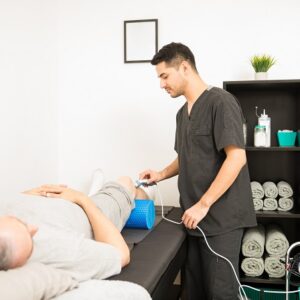After the invention of therapeutic ultrasound, How does therapeutic ultrasonography work? is widely used question. In past times only the point of concentration was diagnostic ultrasound but Low-power ultrasound waves are used in non-invasive therapeutic ultrasound treatment to cause vibrations and increase the temperature of bodily tissue in a specific area, relieving pain and loosening up tight muscles. In order to encourage healing of the injured area, the technique can help break up scar tissue and increase blood and lymph circulation. It is used to treat minor orthopedic injuries and persistent pain. We are going to explain How does therapeutic ultrasonography work? in clinics and hospitals.
Hospitals may employ therapeutic ultrasonography during inpatient stays to assist patients in healing from orthopedic injuries or disorders. A registered physical therapist often carries out this procedure on an outpatient basis. Here we will answer the question How does therapeutic ultrasonography work?
Read More: you can also read about therapeutic ultrasound guide.
Table of Contents
Types of Therapeutic Ultrasonography
Before understanding How does therapeutic ultrasonography work? The types are explain here to fully conceptualized the working of ultrasound machine.
Therapeutic Ultrasound
Treatment for pain from minor orthopedic injuries like sprains and strains typically involves thermal ultrasounds. An ultrasonic device targets a specific body part with deep heat during the process. Deep tissue penetration allows it to warm the damaged tissues, which helps to ease pain, increase circulation, and speed up the healing process.
Mechanical Ultrasound
A mechanical ultrasound uses light vibrations to break up scar tissue and create gas bubbles close to the injury by vibrating the soft tissue in the affected area. These bubbles’ expansion and contraction may lessen swelling and inflammation brought on by injuries, aiding in the repair of soft tissues.
How does therapeutic Ultrasonography work?

Different machine, models and generations of ultrasound operated differently. How Does Therapeutic Ultrasonography Work? to answer this question we will explain general procedure here. When we give an electrical charge to the tiny crystal housed inside the ultrasound machine, ultrasonic waves produces. During treatment, these waves are transmitted to the wounded soft tissue through the ultrasound head or transducer, improving blood flow and oxygen delivery while having therapeutic effects.
A therapist will apply conductive gel to a particular body part when administering therapeutic ultrasonography to a patient. The therapist gently moves the ultrasound machine’s transducer head in circular motions on the skin. The ultrasonic waves’ penetration depth may need to change in specific circumstances. Ultrasound therapy sessions typically last 5 to 10 minutes and are only administered once daily or less.
Settings
How does therapeutic ultrasonography work? to understand the procedure we will do setting of apparatus, patient and therapist. The therapist can adjust the ultrasound unit’s settings to alter the intensity or depth of the ultrasound wave’s penetration. Additionally, they might employ multiple settings at various stages of recuperation. Make ready the whole apparatus, gel, electricity wires and positions the patient accordingly.
Method
If the body area is bony and rough or if there is an open wound, alternative ultrasonic application techniques are possible. (Bacteria that can infect the wound may be present in the ultrasound gel and probe head.). The following methods are used for the application of ultrasound:
- A direct exchange method
- Bladder method method
- water immersion method
- gel immersion (most commonly used method)
Procedure -How Does Therapeutic Ultrasonography Work?

Ultrasound and Medicine
Physical therapists (PT) might use ultrasound gel with a topical drug to treat inflammation around the body’s soft tissue. Phonophoresis is the name of this procedure. A doctor, a physical therapist, or an ultrasound expert can perform phonophoresis. The Doctor could suggest seeking ultrasound treatment at a clinic specializing in it.
The Doctor or therapist will operate in three steps. They will first apply a medicinal ointment or gel on the skin close to an injured or inflammatory joint or muscle. Medications, including hydrocortisone, dexamethasone, and lidocaine, are frequently used in phonophoresis. The area where the topical treatment will then receive an application of the ultrasonic gel. The gel facilitates the passage of ultrasonic waves through the skin.
The region where the topical medication and gel gave will next be treated with an ultrasonic head instrument. The drug is delivered into the body through the skin using ultrasound wave frequencies. While there is proof that ultrasound waves aid in delivering the medicinal gel to the wounded tissues, most published studies suggest that this remedy may need to be more successful. This is How Does Therapeutic Ultrasonography Work?
According to an additional study, phonophoresis is superior to ultrasound therapy for treating knee osteoarthritis problems.The prevailing consensus is that phonophoresis is more potent when combined with other medicines or treatments. For carpal tunnel syndrome or De Quervain’s tenosynovitis, a wrist splint may use in addition to ultrasound with medicine. According to a dependable source, phonophoresis works best when applied in conjunction with a dressing for a wound. For improved outcomes, dexamethasone and a dressing, a kind of wound treatment, can be utilized at least 30 minutes before using ultrasonic waves.
Uses/Indications
Candidates for therapeutic ultrasounds include individuals with the following conditions:
- Tendonitis
- Bursitis
- Muscle tears
- Ligament injuries
- Sprain and strain
- Joint contracture
- Rotator cuff tears
- Meniscus tears
- Chronic neck and low back pain
- Carpal tunnel syndrome
- Shoulder pain
- Muscle, joint, and ligament edema.
- Ligament injuries
- Joint tightness
- We use Ultrasound technology to treat a variety of medical issues. The most common use, however, is to treat problems with muscular tissue. The heating effect of ultrasound helps to relieve muscle pain and reduces chronic inflammation
- Additionally, ultrasound enhances tissue fluid flow, which causes more lymph to circulate through the tissues. Lymph, a necessary fluid, transports white blood cells throughout the body. So, in this way, ultrasound helps wounded cells recover more quickly and fight infection
Benefits
The benefits of ultrasound physical therapy are numerous:
- The process is typically straightforward and painless. There will be no need for anesthesia or painkillers because they will awake throughout the procedure.
- When carried out properly by the therapist, therapeutic ultrasonography has no known adverse effects.
- Boost blood flow to the tissues.
- Increase the rate of healing.
- Lessen the agony
- Enhance the elasticity
- The treatment will aid in reducing physical discomfort in the affected regions.
- It is non-invasive, and ultrasound physical therapy is safer than conventional treatments.
prove current therapies and therapy monitoring to guarantee the most patient benefit from therapeutic ultrasound.
The first clinical use of ultrasonography for physical therapy dates back to the 1950s and is frequently referred to as simply “therapeutic ultrasound” (Robertson & Baker, 2001). These days, this modality typically consists of a hand-held transducer and a base unit that produces an electrical signal. How Does Therapeutic Ultrasonography Work? Physical therapy technicians with the appropriate training apply coupling gel to the hand-held transducer and move it in a circular motion over an injured or painful portion of the anatomy to treat problems like shoulder bursitis or tendonitis. Warm tendons, muscles, and other tissue which you want to promote blood flow and hasten recovery. The coupling medium may also contain different substances to improve the therapy.
By encouraging the compound’s entry into the skin, ultrasound application—also known as phonophoresis- can help (Machete & Boucaud, 2002). In sports medicine, mostly used medications like lidocaine and cortisol. Physical therapy ultrasound therapies’ potential clinical value to patients is still unknown (Robertson & Baker, 2001; Baker et al., 2001; Alexander et al., 2010). When the modality used correctly, the risk of injury, such as burns, appears to be low. Overall, ultrasonography is for physical therapy with a low level of risk and a minor amount of patient benefit.
Summary
Physical therapists frequently utilize a tool called therapeutic ultrasonography. It should always be a part of a comprehensive treatment plan that includes exercise, stretches, and other targeted activities as a part of treatment.
Phonophoresis, ultra-sonophoresis, enhances the effects of a topical medication using an ultrasound. PTs use it to treat some chronic pain and injuries. Hopefully you got the answer of frequently asked question How does therapeutic ultrasonography work?
Frequently Asked Questions
Q: Why do physical therapists utilize ultrasound?
Ans: In physical therapy, Therapeutic ultrasonography works to soften adhesion and deep heating of tissues.
Q: How does therapeutic ultrasonography work?
Ans: Low-intensity ultrasound therapy improves soft tissue recovery after injuries to ligaments, tendons, skeletal muscles, and the tendon-bone junction, according to a 2016 study published in the Internal Medicine Review. How Does Therapeutic Ultrasonography Work? According to the study, the first two weeks after the injury are the most beneficial for ultrasonic treatment intervention, and many patients report better overall results. However, the outcomes of therapeutic ultrasound treatments provided during inpatient hospital stays may be less reliable due to restrictions on application frequency and treatment length.
Q: What is a therapeutic ultrasound’s indication?
Ans: Muscle spasms, muscle discomfort brought on by IVDD, tendinopathy, delayed wound healing, and injuries from muscle tension are among the indications for therapeutic ultrasonography. Duty cycle, frequency, intensity, and treatment duration are all setting variables for therapeutic ultrasound.
Q: What purpose does therapeutic ultrasonography serve?
Ans: In Chronic pain, therapeutic ultrasonography also aids tissue recovery. If you encounter any of the following ailments, it might be advised: palmar-plantar syndrome frozen shoulder is one cause of shoulder pain. The sound waves, also known as ultrasound rays, penetrate the body, producing heat, boosting blood flow, and relaxing muscles and connective tissues to lessen pain and muscular spasms. By stimulating these tissues, injuries can heal quicker and are more likely to stimulate repair.
Q: Why does therapeutic ultrasound employ gel?
Ans: Because air makes it difficult for ultrasound sound waves to pass through, ultrasound gel shortens the distance between the patient and the transducer. This effect reduces acoustic impedance and reflection, which makes it possible to obtain a crisp image.

2 Responses